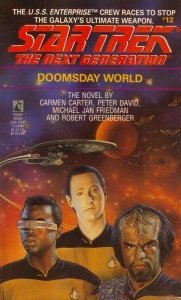Doomsday World
 Writing is generally seen as a solo affair, though some team ups can be really useful. (Larry Niven was almost always far better with a co-author.) That said, seeing four authors on a book really makes one wonder just what was going on. Thankfully, there’s a good introduction talking about how this particular collaboration came to pass, which boils down to some group luncheons with the NY-area Star Trek novel writers..
Writing is generally seen as a solo affair, though some team ups can be really useful. (Larry Niven was almost always far better with a co-author.) That said, seeing four authors on a book really makes one wonder just what was going on. Thankfully, there’s a good introduction talking about how this particular collaboration came to pass, which boils down to some group luncheons with the NY-area Star Trek novel writers..
The list of authors isn’t bad either: Carmen Carter wrote Dreams of the Raven, one of my all-time top recommendations for TOS Star Trek novels. Michael Jan Friedman has written several TNG novels, of which I’ve only read Crossover, which wasn’t stellar, but was a lot of fun. Peter David is a very prolific and consistently good Star Trek author, in several media, including the novel Q-in-Law, one of the few TNG novels I highly recommend. Robert Greenberger is the only author that I haven’t read something else by, but it turns out he’s the one to get this project properly organized.
Having just read Gulliver’s Fugitives (TNG #11), it was quite nice to find that this novel had more characterization in the first ten pages than the previous had throughout its length. In fact, it’s obvious the team deliberately set up little character moments for the entire regular cast throughout the first couple of chapters. The emphasis on on this continues throughout the novel, though extraneous characters are dropped as the plot tightens up and starts moving. The real problem here is more over-characterization. Most notably, Data has far too many moments where he trips over an idom and Geordi has to explain. This is something that he has trouble with, but obviously, once he’s had one explained, he wouldn’t need it explained again, so he wouldn’t need them all explained, and the frequency here feels well off from the series.
The plot itself is a mixed bag. We get a new small insterstellar government, the K’Vin, a planet they hold jointly with the Federation, and a large archaeological dig uncovering secrets of an earlier, vanished race. The setup is nicely done, we get to meet a mentor figure for Geordi, the Federation and K’Vin ambassadors, and then we get an attack on a settlement in another system to get the plot moving.
The initial effect of this is to force the Enterprise elsewhere while leaving Data, Geordi and Worf are on-planet as tensions start ratcheting up with a string of terrorist attacks. The plot does keep the promise that this will all tie up in the end. In fact, structure-wise, there’s no real problems. However, we do get problems with the main characters not being quite as competent as they should be, and missing things that the reader picks up on.
Some of that is the reader getting to know more than the characters, and some of it is some really ham-fisted stage direction early on. As we go on, we do get to see more and more what’s going on with the ‘primary villains’, which if that had been done a bit earlier and better would help shore things up a bit. But even then, the ending kind of dissolves into a mess where what should be important elements sideline themselves, and it feels more like an early decision ‘and this is what the final scene should look like’ without it being allowed to flow naturally out of the rest.
All that said, this still makes for a better early TNG novel than what I’ve seen so far (I’ve read about seven of #1-11). It falls short in places, but is a good effort, and certainly not to be avoided.

Discussion ¬